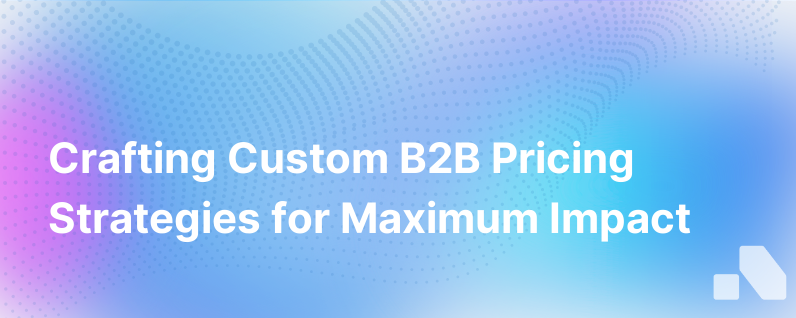
In the intensely competitive landscape of B2B sales, crafting the right pricing strategy is pivotal. Unlike B2B products which often come with fixed tags, B2B services are dynamic and can vary greatly depending on numerous factors, such as the scope of services, client size, and project complexity. The cogency of your pricing model can be the difference between a thriving business and one that struggles to convert sales into profitable, long-term relationships.
B2B sales are inherently more complex than B2C transactions, and the pricing strategies involved must reflect this complexity. Developing a tailored pricing model for your B2B service is not merely a function of costs plus profit. It demands a deeper understanding of value perception, customer needs, and the competitive landscape.
Here's an in-depth exploration of how to develop a tailored pricing model in the domain of B2B services.
Understand Your Value Proposition
Your pricing strategy begins with identifying what you offer that's uniquely valuable to your customers. Are you saving them time? Helping them reduce costs? Or offering them a blend of expertise and service that no one else can? Each service component that adds demonstrable value can be a pillar of your pricing model.
For B2B services, it is also crucial to distinguish between perceived and actual value. Perceived value is subjective and can shift based on customer impressions and market trends, while actual value is grounded in the tangible benefits your service delivers. Your pricing model should cater to both.
Dive Deep into Customer Profiles
To develop a pricing model that resonates with clients, it's necessary to segment your potential market. Segmenting involves classifying potential clients by industry, company size, budget, or specific pain points. By understanding these facets, you can tailor your pricing strategies for different customer groups.
For example, enterprise-level businesses might value long-term contracts with comprehensive support, while smaller startups may prioritize flexible, pay-as-you-go models.
Implement Value-Based Pricing
Beyond the cost-plus pricing model, where you tack on a standard markup to your costs, there's the concept of value-based pricing. This strategy revolves around the perceived worth of your service to the customer.
It takes into consideration factors like how much money your service can save the client, the strategic advantages it might provide, or the revenue it could potentially help generate. To get this right, you'll need to have in-depth discussions with your customers, conduct market research, and perform competitive analysis to understand what the market will bear.
Competitive Landscape Analysis
An overlooked aspect of pricing is the competitive analysis. What are your direct competitors charging for similar services? How do you position your pricing in comparison? It's crucial to strike a balance between competitively pricing your services while also not undervaluing them.
Establish benchmarks and monitor fluctuations in the market regularly. By keeping an eye on your competitors, you can adapt your pricing strategy to stay ahead or introduce innovative pricing structures that set you apart.
Cost Analysis
Before you set any prices, you need to have a firm grasp on your cost structure. Understand all direct and indirect expenses involved in your service delivery, from staff hours to technology investments. This baseline understanding is critical not only for profitability but also for ensuring that your tailored pricing models reflect the sustainability of your service delivery.
Flexibility and Innovation in Pricing Models
We're seeing a trend towards more dynamic and usage-based pricing models. These models can be particularly attractive in the B2B space, where service usage can vary greatly from client to client. This kind of pricing provides the flexibility that many businesses desire and aligns the cost directly with the value they receive.
However, while such models are innovative, they must be administered with caution to avoid confusion and maintain a sense of fairness and transparency.
Feedback and Continuous Optimization
Creating the ultimate pricing model for your B2B service is not a "set and forget" task. It requires ongoing tweaks and adjustments. Listen to customer feedback, monitor sales data, and observe how each pricing model affects client satisfaction and retention.
Experiment with different models on a small scale before rolling them out broadly. A/B testing pricing strategies can lead to valuable insights and help refine the approach.
Conclusion
Tailored pricing models are central to success in B2B sales. A well-thought-out pricing strategy will reflect not only the value of the services provided but also the unique needs and perspectives of your clients. It's a balancing act requiring regular adjustments and analysis, always with the goal of fair value exchange at its heart.
As you refine your pricing models, consider how technology, like AI-driven platforms, can streamline the process. A platform like Aomni, for example, could aid in gathering real-time account research, competitive insights, and even the efficacy of sales content — factors that could inform smarter pricing strategies with minimal effort on your part. In the end, the objective is not just to sell but to do so strategically, solidifying profitable, enduring relationships that anchor your business in any market climate.
Sources:
- Value-Based Pricing Model for your B2B and SaaS Business
- Top B2B Pricing Strategies: Examples and Guide | Vendavo
- B2B Pricing Strategies: Examples of Models & Approaches
- B2B Pricing Strategy: Different Models + Best Practices
- 2022 B2B Sales and Pricing Trends: The Rise of Real-Time - Zilliant
- B2B Pricing Strategy: How to Boost Revenue Without Raising P
- B2B Pricing Models & Strategies [+ Pros and Cons of Each]
- A Quick Guide to Value-Based Pricing